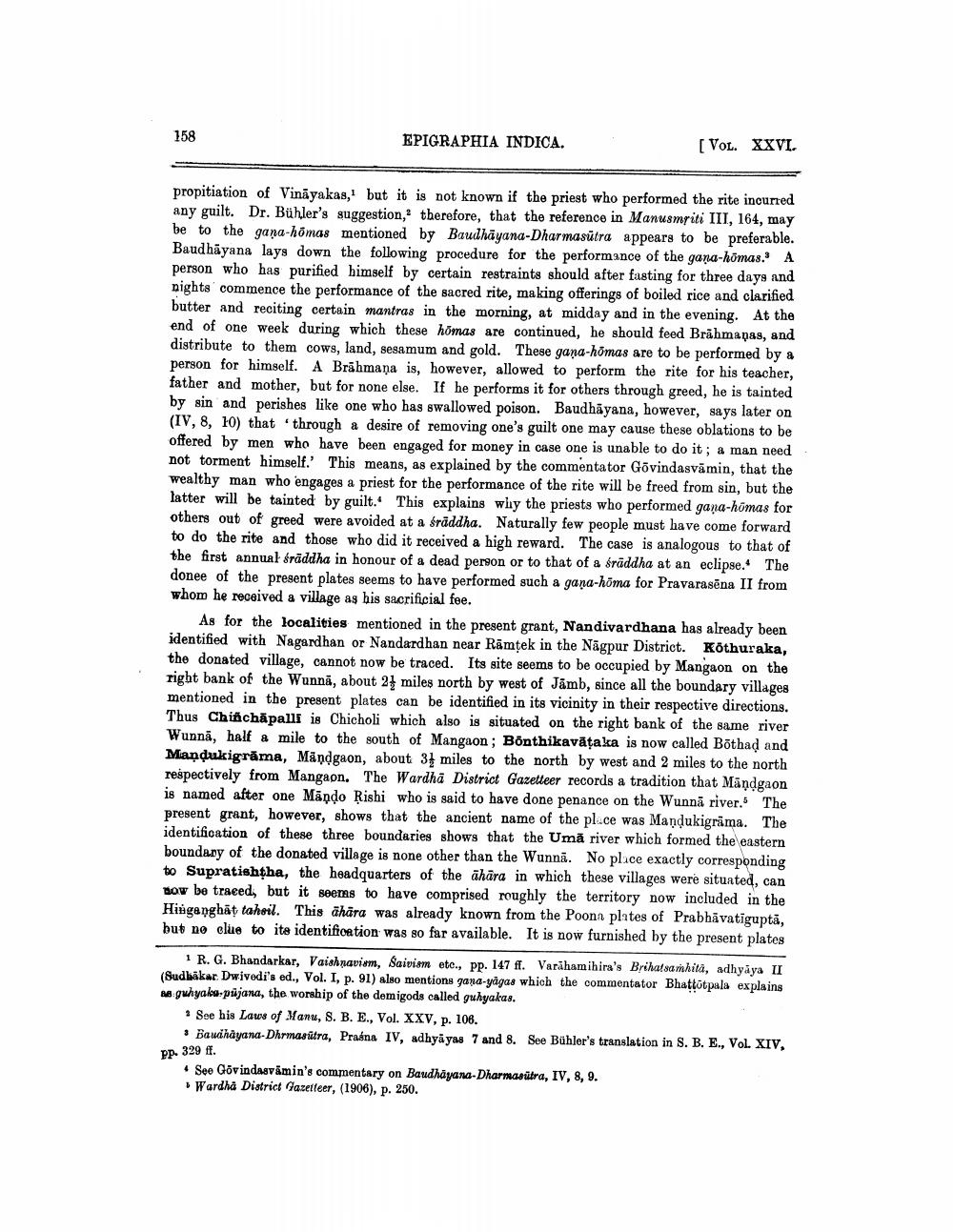________________
158
EPIGRAPHIA INDICA.
[Vol. XXVI.
propitiation of Vinayakas, but it is not known if the priest who performed the rite incurred any guilt. Dr. Bühler's suggestion, therefore, that the reference in Manusmriti III, 164, may be to the gana-hömas mentioned by Baudhāyana-Dharmasūtra appears to be preferable. Baudhāyana lays down the following procedure for the performance of the gana-hömas. A person who has purified himself by certain restraints should after fasting for three days and nights' commence the performance of the sacred rite, making offerings of boiled rice and clarified butter and reciting certain mantras in the morning, at midday and in the evening. At the end of one week during which these homas are continued, he should feed Brāhmaṇas, and distribute to them cows, land, sesamum and gold. These gana-homas are to be performed by a person for himself. A Brāhmana is, however, allowed to perform the rite for his teacher, father and mother, but for none else. If he performs it for others through greed, he is tainted by sin and perishes like one who has swallowed poison. Baudhāyana, however, says later on (IV, 8, 10) that through a desire of removing one's guilt one may cause these oblations to be offered by men who have been engaged for money in case one is unable to do it; a man need not torment himself.' This means, as explained by the commentator Govindasvāmin, that the wealthy man who engages a priest for the performance of the rite will be freed from sin, but the latter will be tainted by guilt. This explains why the priests who performed gana-homas for others out of greed were avoided at a bräddha. Naturally few people must have come forward to do the rite and those who did it received a high reward. The case is analogous to that of the first annual śräddha in honour of a dead person or to that of a śrāddha at an eclipse. The donee of the present plates seems to have performed such a gana-homa for Pravarasēna II from whom he received a village as his sacrificial fee.
As for the localities mentioned in the present grant, Nandivardhana has already been identified with Nagardhan or Nandardhan near Rämtek in the Nāgpur District. Köthuraka, the donated village, cannot now be traced. Its site seems to be occupied by Mangaon on the right bank of the Wunnā, about 2 miles north by west of Jämb, since all the boundary villages mentioned in the present plates can be identified in its vicinity in their respective directions. Thus Chinchāpalli is Chicholi which also is situated on the right bank of the same river Wunnā, half a mile to the south of Mangaon ; Bonthikavăţaka is now called Bothad and Mandukigrama, Mändgaon, about 31 miles to the north by west and 2 miles to the north respectively from Mangaon, The Wardha District Gazetteer records a tradition that Māndgaon is named after one Māņdo ķishi who is said to have done penance on the Wunnā river. The present grant, however, shows that the ancient name of the pl.ce was Mandukigrama. The identification of these three boundaries shows that the Umă river which formed the eastern boundany of the donated village is none other than the Wunnā. No place exactly corresponding to Supratishtha, the headquarters of the āhāra in which these villages were situated, can now be traced, but it seems to have comprised roughly the territory now included in the Hisganghāt tahoil. This āhāra was already known from the Poonn plates of Prabhāvatiguptă, but no clue to its identification was so far available. It is now furnished by the present plates
1 R. G. Bhandarkar, Vaishnavism, Saivism etc., pp. 147 ff. Varahamihira's Brihatsamhita, adhyaya II (Sudhakar Dwivedi's ed., Vol. I, p. 91) also mentions gana-yagas which the commentator Bhattotpala explains 1 guhyaku-pujana, the worship of the demigods called guhyakas.
* See his Laws of Manu, S. B. E., Vol. XXV, p. 106.
Bawihavana-Dhrmasitra, Prahna IV, adhyâyas 7 and 8. See Bühler's translation in S. B. E., Vol. XIV.
Pp. 329 ff.
* See Govindasvämin's commentary on Baudhayana-Dharnasutra, IV, 8, 9.
Wardha District Gazetteer, (1906), p. 250.




